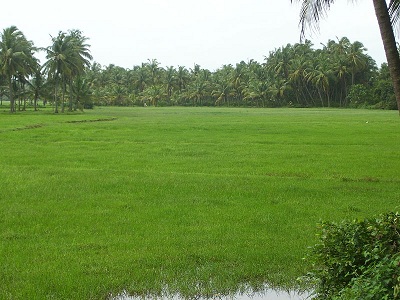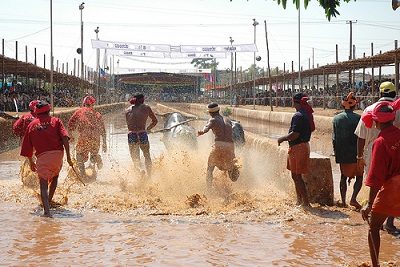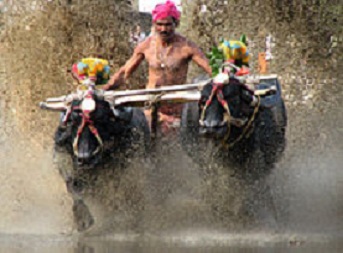Kambla ( Buffalo Race ) - A popular sport of South Kanara
Kambla and its tradition
Kambla has been in existence for more than a 600 years but nobody can definitely say when this ritual sport was introduced in the history of this land. However , according to reports available the ritual and the sport has been designed {to activate and invigorate the buffaloes that take important role in the agriculture as well to prepare the agricultural field for rich harvest, which was considered as wealth and prosperity (‘poli’) in the days of early civilization.
Most of the people in South Kanara are basically agriculturist in nature and it is but natural that Kambala is a one of the popular traditional sport in the region. Kambala or Kambla is the native sport of Tulu Nadu region consisting of South Kanara and Udupi districts in Karnataka. To this day Kambla is an eagerly awaited event each year in the whole region. Certain paddy fields are specially earmarked for this event and the entire area is known as Kambla this or Kambla that. There is a Kambla road which is the road that passes in front of a field where Kambla is held every year in the month of December. This year it was held on the 2nd of December.

The main attraction and a distinct feature of Kambala, which is nothing but Buffalo Race is the kind of fan following it has among all people regardless of religion, caste ,class or creed.Local people simply love this special event since it is part and parcel of Tulunadu (land of tulu speaking people )and portrays its special culture and heritage.The event has many sponsorers who take care of most of the arrangements.
This folk sports event has had a history of royal patronage right from the days of the Arasas of Mulki, The kings of Alupa dynasty in Kadri ( Mangalore ) and also other royal families of Kundapur, to the prominent leaders of the community today. The kambla normally includes 'kesarugadde ota' ( which is a buffalo race that takes place in the field covered with slushy mud)and 'tug-of-war' ( which is again conducted between two rival parties of men in the slushy field) 'teppangai' ( treasure hunt ) competition and the final conferring of 'Guttu Award' sponsored in memory of Kedubari Guruvappa Poojary, owner of a number of Kambla racing buffaloes in recognition of his services to furthering this folk art.It is because of his continued efforts that this sport has survived and has been glorified today.
What it involves
Kambala is organised months in advance since the buffaloes participating and the men who are monitoring them need to train for the event. They practice in other slushy fields for months together to train themselves and their buffalos. The prized Kambla buffalos which are owners pride and are considered to be status symbol among the tuluvas, are fed with the right amount of protein rich food and is given vitamin supplements and other nutrients. Since most of the owners come from agriculturist households , they are given monetary help to look after the animals. This done by disbursing the funds accumulated through donations given by the patrons. They are also given other requirements like adornments . The buffaloes are the stars of the entire show. The buffaloes are washed and adorned with leaves, flower garlands and tinsel.
Kambla begins in the afternoon after an early sumptuous lunch is served to the participants both buffaloes and men who participate in other events . The event normally goes on until sunset. However , there are many other Kambalas held in South Kanara and Udupi districts that begin in the afternoon, and go on throughout night and sometimes continue till the next noon. These are special events organised on a very large scale with many rounds of participation!
Before being taken to the field the buffaloes are smeared with vermillion and an arathi done to ward off evil eye and taken on a round to all the prominent family members called the Guttu families. This is a respect shown to the members for having taken care and nourished this unique sport that is not found anywhere else. They also parade in front of the chief guest who could be bank officials, local Politicians , Doctors , prominent industrialists like Vijay Mallya or film stars like Sunil Shetty, Shilpa shetty, Aishwariya rai who all have their origins in south kanara who are often seen at these events , mingling with the crowd and enjoying the sport.

The Show begins
When the buffaloes are brought to the side of the field there is a lot of cheering by the crowds who gather by the side of the slushy field and on the side roads , which are all closed for traffic on the day of Kambla. There will be drum beats and people playing various other musical instruments, welcoming them .The buffaloes then plunge into the slushy fields and are made to run the entire length of the field, along with one accompanying the trainer. As they emerge out of the fields covered with muddy and slushy waters coming upto the knees, the crowd cheers them once again. Now the other events will be played out.
The rhythmic beat of the heavy drums and trumpets reverberates in the air and the entire area is by now jam-packed. But the show is very well organised with a arena where all the prominent leaders and organisers and judges sit and with the spectators’ stands on the sides of the field with a well defined boundary to keep the spectators in check.
The next procedure is checking the buffaloes’ teeth by a specialist after which the buffaloes are partitioned into different groups according to the number of their fallen teeth. The trainers are all well built with six packs, bare-chested wearing new mundus ( dhotis) normally red or saffron in color, some wear even white which of course turns muddy after the very first test run.
More action
An enclosure is made for the buffaloes waiting in line for their turn, however they do get excited and it is difficult to control some of them who are raring to be free and have a go at the slushy track. When they have to go for the test run they are more than ready to do the honors. The buffaloes look menacing with their taut muscles ,flared nostrils quivering with excitement and agitated by the incessant whipping and loud cries of the trainer(who is incidentally called Saarathi) behind them, they rush past at maddening speed leaving a trail of slushy water flying behind them.
Many of the buffaloes cover the length of the track in a mere 10-15 seconds although it is not easy for the trainer to do so in muddy waters that are knee deep water keeping pace with galloping . Many trainers are unable to keep up with the sturdy buffaloes and fall into the slush. However there are some men who make it look really easy as they run with the buffaloes.
Mutthappa Rai who was a dreaded underworld don turned social worker is a huge patron of this sport and donates and maintains several buffaloes and trainers that participate in the Kambla races.Food is in plenty at these events and a wide variety of all the mouthwatering dishes that are special to South Kanara are available organised by the patrons - like Kori Rotti, Neer dosa and chicken gasi, Bangude gasi and boiled rice, fried fish and a variety of vegetarian dishes and sweet dishes like cashew nut payasa, sheera and fruit salad! T
he bands are playing and the main event begins when the charged buffaloes r run even faster and splash more water in the process. It is as adventurous as it can get! The media is there in full attendance to capture the photo finish of the race and there are celebrities from all over India.

The photo finish
As the race begins right in the middle of the track some markers are placed at the height of 6.5 and 7.5 feet respectively. The idea is that the splashing water should rise to this height and splash on to the markers . The Saarthi stands on a plank attached to the buffaloes on either side and spurs them on to run faster.
In the evening the floodlights cast obscure reflections on the track and by now the stage is filled with dignitaries . As the first pair of buffaloes arrive with the Saarthi on the plank , it looks almost ethereal with the only the man visible through the fountain of water rising all around the buffaloes. The Saarathi seems to be hanging on to nothing but thin air and when the trio ( two buffaloes and the trainer) approach the middle of the track, where the markers are placed, the water astonishingly rises to great heights and manages to touch the 6.5 ft mark or even the higher track. The one who manages to hit the highest point on the marker with the slushy water is considered the winner and the person gets many gifts including a gold coin and cash prize.
There have been times when the trainer gets hurt because of the danger involved here and the proximity to the buffaloes who are charged and often run wild! But the daring youngsters from the region take it as a challenge and train for the even each year.In fact the more such accidents the more eager and in larger numbers they come to participate and win.
I have had the opportunity of watching Kambla several times and each time I experience the same thrill and feel happy when the buffaloes and saarathi we bet on wins. There is a lot of betting going on here. Kambala is open for all without any charges, with the organizers and promoters bearing all the expenditure and are very glad when the arena gets filled to capacity.
The one that normally takes place in the field is called the Arasu Kambala in honor of the Mulki kings who patronised it and made it popular among the masses. There is also Devara Kambala ( Kambla played in honor of God) which is normally played in the presence of the priests and in a field in front of the Temple or close to a temple. This is normally sponsored by a rich devotee whose wish has been fulfilled and he wants to show his gratitude to the deity. This is not something that is regular like Arasu Kambla which is organised every year at different places in South Kanara like Dharmasthal, Pilikula, Kundapur, Mulki, Kinnigoli, Katpadi,Jeppina mogaru and Kadri.
Like it on Facebook, Tweet it or share this article on other bookmarking websites.
